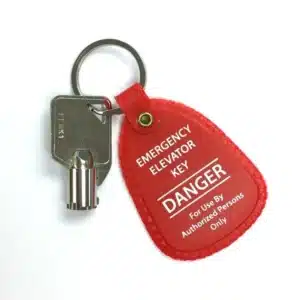In emergency situations, speed and efficiency are critical, especially for firefighters responding to incidents in high-rise buildings. The FEO-K1 firefighters elevator emergency control key is a vital tool that enables rapid access to elevators, allowing firefighters to reach affected floors more quickly and effectively. This article explores the functionality, significance, and regulations surrounding the FEO-K1 key, highlighting its role in emergency response.
What is the FEO-K1 Firefighters Elevator Emergency Control Key?
The FEO-K1 firefighters elevator emergency control key is a specialized key that allows firefighters to take control of elevator systems during emergencies. By bypassing standard operational protocols, the key enables firefighters to direct elevators to specific floors without waiting for passenger commands, thereby facilitating faster access in life-threatening situations.
Key Features of the FEO-K1 Key
- Rapid Access: The primary function of the FEO-K1 key is to provide immediate access to elevators during emergencies, significantly reducing response times.
- Safety Control: This key allows firefighters to ensure that elevators are used safely, preventing them from being called to floors with active fire hazards.
- Compatibility: The FEO-K1 key is designed to work with elevators that comply with certain fire safety standards, ensuring a unified approach to emergency management across different buildings.
How Does the FEO-K1 Key Function?
Mechanism of Operation
When firefighters insert the FEO-K1 firefighters elevator emergency control key into the elevator control panel, it activates a special mode that grants them full control over the elevator’s operations. Here’s how it works:
- Bypassing Passenger Control: The key allows firefighters to override normal passenger controls, which means they can take the elevator directly to the designated floor without stopping for other passengers.
- Manual Control: Firefighters can also control the elevator’s functions manually, ensuring they can respond to the specific needs of the situation.
- Emergency Mode Activation: Once activated, the elevator will only respond to commands given by the firefighters, allowing them to use it as a safe means of transport.
Compliance and Regulations

In many jurisdictions, the use of firefighters’ elevator control keys is mandated by local fire codes. The FEO-K1 key is in line with standards set by organizations like the National Fire Protection Association (NFPA). For example, NFPA 101 outlines the requirements for the installation and operation of firefighter control keys in high-rise buildings, ensuring that they are readily accessible to emergency responders.
Statistical Insights on Elevator Use in Emergencies
Understanding the impact of elevator use during emergencies can provide valuable context for the importance of the FEO-K1 firefighters elevator emergency control key. Here are some key statistics:
- Response Time Reduction: According to the International Association of Fire Fighters (IAFF), using elevators with firefighter control systems can decrease response times to upper floors by approximately 10-20% compared to using stairs.
- Safety Enhancements: A report by the National Fire Protection Association indicates that using controlled elevators during emergencies significantly reduces the risk of injury to both firefighters and civilians.
- Increasing High-Rise Incidents: The National Fire Incident Reporting System (NFIRS) notes that nearly 50% of fire incidents occur in structures over three stories tall, emphasizing the need for effective emergency access systems like the FEO-K1 key.
Advantages of Using the FEO-K1 Key

- Enhanced Efficiency: The FEO-K1 key streamlines operations, allowing firefighters to focus on their primary mission of saving lives rather than dealing with logistical challenges during emergencies.
- Improved Coordination: The use of the key fosters better communication and coordination among firefighting teams, as they can quickly and effectively manage elevator operations.
- Training and Preparedness: Regular training sessions that include the use of the FEO-K1 firefighters elevator emergency control key ensure that firefighters are familiar with its operation and can utilize it effectively during real emergencies.
Conclusion
The FEO-K1 firefighters elevator emergency control key is an essential tool for modern firefighting operations, particularly in high-rise buildings. By enabling rapid and safe access to elevators, it enhances the efficiency and effectiveness of emergency response efforts. As urbanization continues to increase and more people reside in high-rise structures, the significance of tools like the FEO-K1 key cannot be overstated.
How prepared is your community in ensuring that firefighters can effectively use tools like the FEO-K1 key during emergencies?










